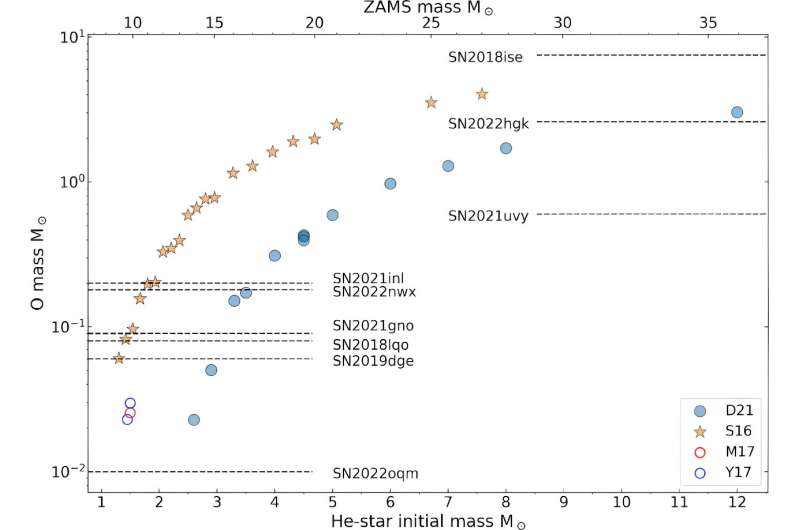This article has been reviewed according to Science X's editorial process and policies. Editors have highlighted the following attributes while ensuring the content's credibility:
fact-checked
peer-reviewed publication
trusted source
proofread
Double-peaked supernovae offer clues to pre-supernova outbursts

New research helps in understanding the evolution and final stages of massive stars, the role of binary interactions, and the mechanisms behind mass loss, which ultimately affect the properties of the resulting supernova and its remnant. This work also provides insight into the different progenitor masses and the scenarios that could lead to different types of mass loss, shedding light on the complex processes that govern the life cycles of massive stars.
The group of researchers offer constraints on the physical properties of these progenitors and suggests possible mass loss mechanisms, enhancing the understanding of stellar evolution and supernova diversity.
Dr. Shing-Chi Leung, an Assistant Professor of Physics at SUNY Polytechnic Institute, was one of the authors of the article titled "Probing Presupernova Mass Loss in Double-peaked Type Ibc Supernovae from the Zwicky Transient Facility," in a collaborative research project with the Zwicky Transient Facility (ZTF) team. The ZTF is a telescope built in Palomar, California, primarily maintained by researchers at the California Institute of Technology (CalTech).
The article is published in the The Astrophysical Journal, and the project was led by CalTech graduate student Kaustav K. Das.
Supernovae are the explosion of stars. Depending on the progenitor, their brightness can evolve to its full brightness within 20—100 days after explosion, and then fade out in the dark sky again.
Traditionally, astronomers need to compare the night sky image with a reference image, and search for unexplained bright spots which could be candidates of supernovae. Then astronomers carry out follow-up observations to record the detailed evolution of the supernova optical signals. The process could be slow as it is not automated, where the long response time could miss out objects that evolve quickly.
The Zwicky Transient Factory is designed to resolve this difficulty with an automated real-time data reduction pipeline, a dedicated photometric follow-up telescope, and a full archive of all detected astronomical sources. This enables the capturing, classification and analysis of transient events in the sky to be continuously done. Since the launch of ZTF in 2017, the telescope has detected about 9,000 supernovae.
With the large number of newly discovered supernovae, a new class of supernovae has emerged. These supernovae feature no hydrogen or silicon in the ejecta (aka Type Ib/c supernovae) and a prominent double peak feature in its brightness, where the first peak occurs promptly about 10 days after explosion.
Normal supernovae mostly show one peak in its luminosity during the entire explosion. The double peak indicates that the star has an outburst phase prior to its final explosion. The outburst is like a "mini-explosion" which sends away some matter in the outskirt of the star. After the outburst, the final explosion occurs and the high-speed matter interacts with this previously ejected matter and creates the double peak signals that were observed.
"In the past, we know very occasionally such supernovae exist but we do not know if they are one-off events, or if there is a systematic picture behind these supernovae," Dr. Leung explained. "With the statistics supported by ZTF, we can believe that a robust mechanism is behind such outbursts. Then the question becomes: do we have a consistent picture to explain these outbursts while we can still explain ordinary supernovae?"
In this project, Dr. Leung studied his prior models where pre-supernova outburst is predicted. They found that the outburst parameter could be consistent with one less-common supernova class known as the Pulsational Pair-Instability Supernovae. However, this class of supernovae is also known to be rare. Thus, it is a matter of debate if this can be the full explanation of this unusual subclass together with the number of events.
"While the conclusion is currently open-ended, it is still exciting to know that supernovae can be more puzzling than we once thought about," said Dr. Leung.
"And we are expecting much more data [to be] available later this decade. The Rubin Observatory (formerly known as the Large Synoptic Survey Telescope) will be deployed in 2025 and the community is expecting to detect about 10 times more supernovae. Such a substantial amount of new data will certainly provide new insights for revealing the less-known side about supernova physics and these peculiar objects."
More information: Kaustav K. Das et al, Probing Presupernova Mass Loss in Double-peaked Type Ibc Supernovae from the Zwicky Transient Facility, The Astrophysical Journal (2024). DOI: 10.3847/1538-4357/ad595f
Journal information: Astrophysical Journal
Provided by SUNY Polytechnic Institute





















